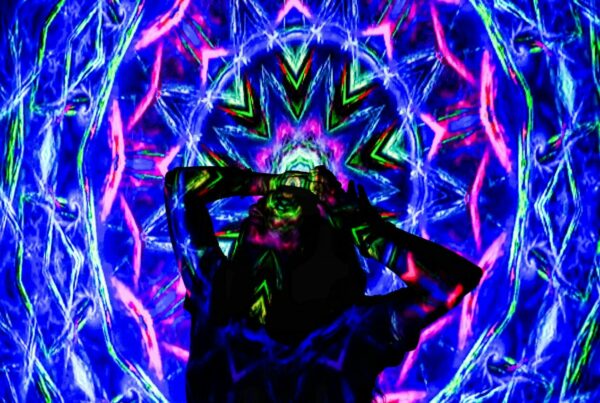Alzheimer’s Disease (AD), a debilitating neurodegenerative disorder that currently lacks a cure, is becoming increasingly prevalent and thus poses a substantial challenge. Researchers are investigating better treatment strategies, paying attention to both natural and artificial alternatives.
Several clinical trials have highlighted the potential of serotonergic psychedelics such as LSD, DMT, and psilocybin in treating Alzheimer’s disease. For additional fascinating perspectives, you are encouraged to explore online resources or contemplate “purchasing psychedelics online in Canada.”
[toc]
Psychedelics’ Contribution to Alzheimer’s Treatment
Traditional psychedelics have potential in treating early-stage Alzheimer’s Disease (AD) or mild cognitive impairment (MCI) by fostering the growth of brain cells.
Psychedelics could potentially induce neural plasticity for learning and memory by targeting specific brain receptors, which could potentially delay or even reverse the neurodegenerative effects of AD. Psychedelics may also help to mitigate depression and anxiety, which are common among AD patients, by inducing positive psychological impacts.
There remains uncertainty about the functionality of psychedelic treatments. While some suggest that profound effects from high-dose psychedelics, such as mystical sensations or a sense of self-dissolution, are vital for psychological benefits, others believe that the biological changes stimulated by these substances are key. Both viewpoints may have merit.
Traditional psychedelics appear to aid the brain in adapting and reducing inflammation, even at lower doses. Therefore, low-dose treatments may be beneficial for conditions such as brain degeneration or migraines without significant mind-altering effects. However, for depression, anxiety, or addiction, the mind-altering effects seem to be essential, leading to introspection and behaviour modifications. Hence, both low and high doses should be studied for personalized therapy.
The Impact of Serotonergic Psychedelics
Serotonergic psychedelics, which include LSD (lysergic acid diethylamide), DMT (dimethyltryptamine), and psilocybin (found in magic mushrooms), are increasingly drawing attention.
The potential therapeutic effects of psychedelics on a range of mental health conditions are garnering increased attention.
Many experts believe that serotonin receptors, which are known for their ability to boost cognition and adjust neuroplasticity, represent a promising avenue for research into Alzheimer’s Disease (AD).
These substances primarily exert their pharmacological effects via the alteration of the brain’s serotonin system, resulting in perception, mood, and consciousness shifts. Here are several research findings that corroborate this perspective:
- In particular, the 5-HT2A subtype of these receptors affects the gene expression of neuroplasticity-boosting neurotrophins in AD-affected brain areas.
- These receptors manage cortical signalling, a process vital for cognition, memory, and synaptic plasticity.
- Despite their atypical distribution within neurons, serotonin receptors play a role in brain development, regeneration, and plasticity.
Significant Research Findings
- Serotonergic psychedelics have shown the potential to alleviate some AD pathology aspects by promoting neuroplasticity.
- Classic psychedelics influence neurotransmission, stimulate synaptic remodelling, and enhance factors supporting neuronal survival.
- Specific psychedelics, like muscimol and Sig-1R agonists, may reduce the neurotoxicity associated with AD progression.
- Classic psychedelics activate pathways in AD-affected brain areas, indicating a potential for slowing or reversing brain degeneration.
- Psilocybin mushrooms instigate neural plasticity, promoting neurogenesis and causing lasting alterations in brain circuits.
- Psychedelics improve brain connectivity by targeting receptor genes and triggering changes in neurons and networks.
Clinical studies suggest that both classic and non-classic psychedelics, including those from magic mushrooms, affect numerous biological processes in the brain. These impacts encompass swift changes in gene expression and substantial modifications in brain structure and function.
These psychedelics interact with receptors such as serotonin, sigma, NMDA, and GABA, leading to increased synaptic plasticity and brain rejuvenation. As a result, psychedelics may have beneficial effects on behaviour, memory, and cognition, positioning them as potential treatments for AD and related conditions.
Buy Psychedelics Online in Canada
Welcome to our digital storefront, offering a wide variety of psychedelic products within British Columbia, Canada. If you’re considering dipping your toes into the world of microdosing magic mushrooms, we suggest starting your journey with a reputable medicinal mushroom dispensary.
- LSD
LSD is a synthetic drug derived from a fungus called ergot that grows on rye grains. This psychoactive compound, even in small quantities, can change perceptions, feelings, and thoughts.
Excessive consumption of LSD could lead to severe hallucinations, warping your sense of time and space. It’s important to be cautious as substances sold as LSD might actually be other drugs such as NBOMe or a member of the 2C drug family.
| Product | Kittease – Ketamine Microdose Troche (30x50mg) | Zenly – LSD Gel Tabs – 600ug (100ug Per Tab) | Zenly – LSD Gummies – Sour Zen Berry – 200ug (100ug Per Gummy) |
| Intended Use | Stress, depression, pain management, PTSD, OCD, work stress, performance anxiety, insomnia, and addiction. | Exceptional experiences | Exceptional experiences |
| Dosage | 50mg per troche / 30 per pack – 1.5 grams of ketamine/ per pack | 600ug total/6 Tabs (100ug/Tab) | 200ug total/2 Gummies (100ug/Gummy) |
| Usage Guidelines | Take one full troche | Consume one full tab for the full effect. Wait at least 2 hours before taking another. | Consume one full gummy for the full effect. Wait at least 2 hours before taking another. |
| Benefits | Quick to take effect with minimal risk, increased openness to experiences, ideal for self-reflection and cognitive improvement. | Dose accurately measured for the perfect trip, confirmed by lab testing | Dose accurately measured for the perfect trip, confirmed by lab testing |
- Magic Mushrooms
Over 180 species of mushrooms are identified to contain psilocybin and psilocin, compounds known for their therapeutic properties and positive impact.
on mental health.The impact can vary based on factors such as the type of mushroom, cultivation conditions, consumed quantity, and individual tolerance. While some people prefer microdosing for milder effects, others opt for larger doses for a more intense experience. Additionally, the quality can be influenced by the cultivation practices used.
The Blue Meanies, scientifically referred to as Panaeolus cyanescens, are small dried fungi that flourish in warm tropical climates, typically on bovine and water buffalo dung. As they grow, they develop blue spots on their surface, giving them their distinctive name.
- These fungi are rich in psilocybin and psilocin, both of which are highly concentrated.
- They have been historically used recreationally, especially among the Balinese community, who consume them during celebrations and for artistic inspiration.
- They are popular among tourists and travelers in Bali and similar areas due to their hallucinogenic effects. These effects can include feelings of happiness, hallucinations, joy, and bouts of intense laughter.
- DMT
DMT, a potent hallucinogenic compound, is found in certain plants like Psychotria viridis and Chacruna. Often dubbed as the “spirit molecule,” these controlled substances can induce deep psychedelic experiences. They offer a short, yet intensely immersive journey characterized by vivid visual and auditory hallucinations.
| Product | Dream Machine – Vape Cartridge – DMT 1ml | Integral Alchemist – ACACIA Changa Pre-Roll | Integral Alchemist – Mimosa- 1ml DMT Vape Cart |
| Description | Explore hyperdimensional spaces with DMT. | Experience ayahuasca-like effects through a mixture of herbs and DMT. | Embark on a journey filled with mystical visions and spiritual insights with DMT. |
| DMT Content | 1g | Approximately 90mg | 1ml |
| Instructions | Preheat the cartridge and inhale | Consume the pre-roll at a pace that suits you. | For immediate effects, inhale the vapor. |
| Effects | Intense hallucinations, altered state of consciousness. | Lengthy, visual psychedelic journey. | Euphoria, spiritual enlightenment, significant changes in perspective. |
| Duration | Varies by individual | Can last up to 1 hour | Can last up to 30 minutes |
Long-Term Effects of Psychedelic Use
Current research is focused on understanding the long-term effects of using psychoactive substances. The term “long-term effects” refers to any lasting changes in cognition, emotion, or memory that occur after extended use of psychedelics.
The study of the long-term effects of psychedelics is complex. Some research suggests potential mental health benefits, while other studies indicate potential risks, such as triggering psychosis.
Despite these complexities, scientists persist in their efforts to understand the effects of long-term psychedelic use on mental health. They are conducting thorough research and tracking individuals over long periods to collect more accurate data.
Purchase Cannabis from a Certified Supplier
Research suggests a significant change in the treatment of Alzheimer’s disease, with psychedelics potentially transforming our approach to brain disorders. Experts believe that the therapeutic use of these substances could completely alter Alzheimer’s treatment, providing new hope for numerous patients and their families.
For high-quality products, choose a certified supplier like Psychedelic Canada. Offering a wide range of cannabis products, including flowers, edibles, concentrates, and more, Psychedelic Canada ensures genuine, lab-tested items that meet strict food and drug standards.
Order shrooms online now.
Frequently Asked Questions
How do psychedelics differentiate from other substances typically used in Alzheimer’s treatments?
Psychedelics distinguish themselves from traditional Alzheimer’s medications through their therapeutic approach and effects. They create new neural connections by impacting the brain’s serotonin system, leading to profound psychological experiences that foster emotional health.
Unlike traditional drugs that primarily manage symptoms, psychedelics are being evaluated by Health Canada for their long-lasting benefits and holistic treatment approach, which includes therapy.
Research into the use
The therapeutic potential of psilocybin for treating obsessive-compulsive disorder and its ability to maintain a safe profile, particularly in preventing multi-system organ failure, distinguishes it from conventional controlled substances.
Can psychedelic-assisted therapy be a viable treatment alternative for Alzheimer’s patients facing existential distress at end of life?
Psychedelic-assisted therapy could potentially be helpful for Alzheimer’s patients who are critically ill and struggling with the approaching end of their lives.
- Provides emotional comfort. This therapy has been found to ease feelings of anxiety and depression in some individuals, particularly those who are critically ill. This may also be beneficial to Alzheimer’s patients.
- Typically safe under professional oversight. Administering psychedelics like these in a controlled setting under the supervision of a trained therapist is usually harmless and well received by most individuals.
- May improve quality of life. For Alzheimer’s patients, an emotional uplift could significantly improve their quality of life, even if there’s no change in memory function.
- Further research is required. Despite the promise of this therapy, additional studies are needed to validate its safety and effectiveness for Alzheimer’s patients, especially those nearing the end of their lives.
How long does a psychedelic therapy session last for Alzheimer’s patients?
- Preparation Phase. This phase involves one or two sessions, each ranging from 1 to 2 hours. The purpose of these sessions is to ready the patient for the forthcoming experience, establish expectations, and build rapport with the therapist.
- Core Psychedelic Session. This crucial session, where the patient consumes the psychedelic substance, typically lasts between 4 to 6 hours. The patient spends this time in a controlled environment, often lying down with eye shades and listening to music, under the vigilant supervision of therapists.
- Integration Phase. After the main session, follow-up meetings are held to help the patient understand and integrate their experience. These sessions usually last 1 to 2 hours each, with the number of sessions varying.
Also, consider checking out:





